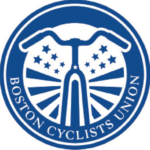City seeks consensus on Rutherford Ave project

The new second option. The city's consultant on the project said the difference between northbound and southbound traffic is due to thousands of suburbanites ducking the tolls on the Tobin Bridge.
For the most part, the bike/ped path alongside Rutherford Street is preserved in the proposed hybrid, but the linear park surrounding the path would be reduced in width by around 15 feet, losing close to a third of an acre of open space over the span of the underpass. Even though the bike path is preserved, some cyclists and other residents in the neighborhood spoke out against the underpass, citing noise, high traffic speeds and the fact that a highway like underpass would continue to deter economic development on what are now several large parking lots nearby.
The city made it clear they would build either the underpass or the surface option depending on what the neighborhood desires, but the most revealing part of the Boston Transportation Department’s presentation on Wednesday night was the vast difference between inbound and outbound traffic on Rutherford. Traffic has dropped by as much as 33% overall on the road since 1997, Michael Hall of the consulting firm Tetra Tech told an audience of over 100 at the new Knights of Columbus hall, but traffic counts also indicated that inbound traffic flow was three times as heavy as outbound traffic. Hall explained that this was likely due to the one-way toll scheme on the nearby Tobin Bridge.
In other words, he said, when suburbanites north of Boston roll into town, a large number avoid paying $3 for the Tobin during rush hour by taking Rutherford, but on the way back home, the Tobin is free, and they prefer it.

The original design for the Rutherford Avenue and Austin Street intersection, which was approved in a well advertised community process that concluded in 2010. This "surface option" would handle the traffic easily and be less expensive, according to the Boston Transportation Department.
Hall stopped short of explaining this well known phenomenon among traffic engineers on Wednesday, but he did say that even if all 1,000 drivers decide to keep avoiding the $3 dollar a day fee and traffic levels remain the same, the underpass would still have an extra lane in each direction that isn’t needed to carry the traffic demand.
“It wouldn’t be safe at just one lane,” he said, referring to the need for a breakdown lane and access for emergency vehicles. The proposed underpass would have two lanes in either direction, though the traffic passing through would technically only require one, and could also be handled by the surface option, which was overwhelmingly approved by a group of community residents in 2010.
Charlestown is now divided on the issue. A large contingent commenting toward the “save the underpass” side sounded off on fears of traffic “backing up” and overrunning other streets in the neighborhood, and a smaller phalanx of residents united under the banner of the “Rutherford Corridor Improvement Coalition” cited the need for slower traffic for safety and noise improvements. Interestingly, the goal of groups on both sides of the issue is getting rid of traffic. The real difference lies in their beliefs in how traffic behaves. According to BTD Commissioner Thomas Tinlin, who was also present at the meeting, his agency will not move forward until some semblance of “consensus” is reached in the neighborhood.
To help inform the debate, the Union is hosting two nationally recognized experts on traffic calming and freeway removal at the MGH Charlestown Healthcare Center on 73 High Street this Tuesday night, May 15 at 6pm. Peter Park has served as planning director in Denver, Colo. and Milwaukee, Wis., and Ian Lockwood is a principal at AECOM, a Fortune 500 engineering firm. Both have had direct experience with projects similar to the Sullivan/Rutherford redesign. Their presentation will be followed by Q and A session.

Your conclusions are some what flawed.
First, the routes into and leaving the city are limited, so, they just isn’t ‘other options’ for these commuters to travel. Yes, we want the surface design so the local traffic is all we deal with (nice and slow), but we want to bury the morning commuter traffic in a tunnel with limited entry & exits from Sullivan Sq to City Sq (Austin St). This is the correct design, the rub here is the cost factor as the city wants a cheap solution that really doesn’t do what they say. Sure, during the day when traffic loads are light it works! the problem is we can’t get rid of the morning or evening traffic running through us. The lights will slow the traffic but we pay the price of the extra noise and smog it will create, let alone the grid lock it will create. The volume of traffic is to great to have the surface design with out a tunnel to get crossing traffic through.
The make this work for bikers, pedestrians and the community at large we need the tunnel. It does not take away what the surface design offers, in fact it makes more space available to buffer the noise and by encapsulating the commuter traffic a means to clean up the smog. Just look at how the North End ended up after the Big Dig. So much quieter and much less smog.
Why can’t Charlestown get the same benefits?
FYI – Half of the tunnel is already built, by closing off the top of the current trench.